Text


Happy Fossil Friday!
Who: Beelzebufo "The Devil Toad"
name meaning: Beelzebub (Lord of the Flies), toad
pronunciation: Bee-ell-ze-boof-oh
What: A horned toad
When: Late Cretaceous
Where: Madagascar
Fun fact!: Is the largest known frog species to have ever existed
Why are they cool?: The head was likely covered in scutes (bits of bony scale-like bone like the plates on the back of a crocodile) giving it a horned, protected cap of bone across its head.
Image Credits: (Right: Prehistoric Planet [TV], Left: New Material of Beelzebufo, a Hyperossified Frog (Amphibia: Anura) from the Late Cretaceous of Madagascar)
#palaeontology#paleontology#fossil friday#fossils#paleo#palaeoart#paleoart#cretaceous#madagascar#toad#frog#beezlebub#beelzebufo#the devil toad#anura
20 notes
·
View notes
Text
A full animation using toon shaders! I'm really liking this style!
8K notes
·
View notes
Text
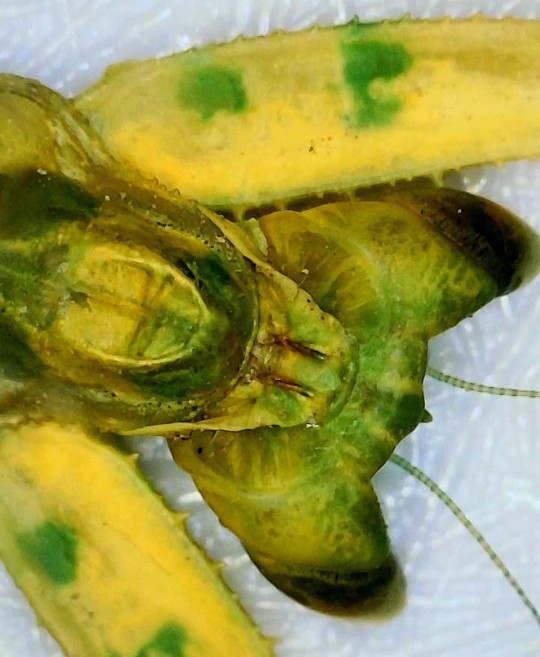


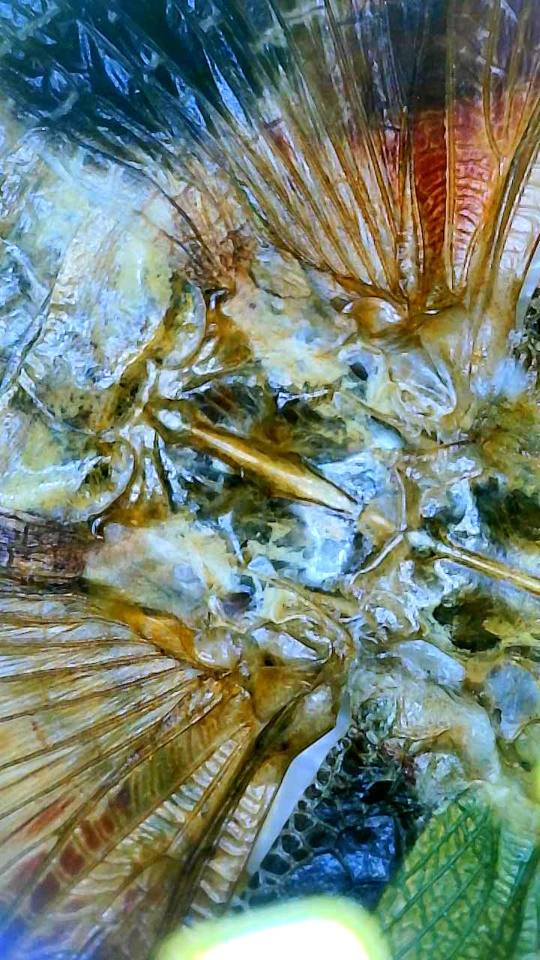
Happy Macro Monday!
For all those who love the living natural beauty of our world as well as that which is preserved in rock, here is a gorgeous specimen of Creobroter gemmatus, the Jeweled Flower Mantis. A lovely species native to Asia.
7 notes
·
View notes
Text
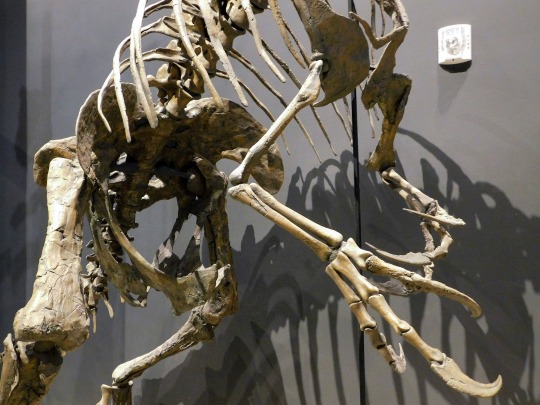

Happy Fossil Friday!
Who: Therizinosaurus cheloniformis
name meaning: "Scythe Lizard" "Turtle Formed"
pronunciation: Ther-i-zine-oh-sore-us kell-on-i-form-iss
What: A large, probably herbivorous theropod
When: Late Cretaceous
Where: Nemegt Formation in the Gobi Desert in Mongolia
Fun fact!: An original description of Therizinosaurus the material was thought to have belonged to a gigantic turtle with huge three foot long claws. This original material was found among much Mongolian turtle material, however reexamination of the specimen showed that it was actually a part of a very interesting dinosaur instead.
Why are they cool?: As one of the few theropods with proposed herbivorous habits, it is an excellent example of convergent evolution (def: the independent evolution of features that appear reminiscent of features that appear in multiple organisms that have no common ancestry, e.g. wings in bats and birds).
The arms of Therizinosaurus have been notably compared to herbivorous mammals such as the Giant Ground Sloth and proposed to employ similar feeding styles of retrieving vegetation for consumption as well as digging for roots in the earth.
Image Credits: (Left: A representative of the Therizinosaurid group not of Therizinosaurus proper - Nothronychus from the Natural History Museum in Utah. Photo taken by M. Rhodes (2019) Right: TheStompingLand.com)
#therizinosaurus#theropod#palaeontology#paleontology#fossil friday#fossils#paleo#cretaceous#gobi desert#mongolia#desert#giant sloth#herbivore
14 notes
·
View notes
Text

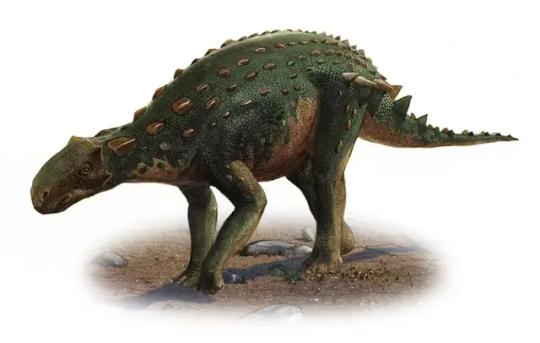
Happy Fossil Friday!
Who: Minmi paravertabra
name meaning: named for Minmi Crossing in Queensland Australia
pronunciation: "Min-mee" "pair-ah-vert-ah-bra"
What: Ankylosaur
When: Early Cretaceous
Where: Australia
Fun fact!: Minmi is widely considered the (or one of) the most basal (oldest, ancestral) ankylosaurids!
Why are they cool?: This species Minmi gains its name from the unique horizontal orientation of ossified tendons along the sides of the vertebral column. There is some debate over the validity of this feature and the status of Minmi as a distinct taxon all together.
Image Credits: (Left: Minmi | Western Australian Museum Right: Sergey Krasovskiy)
#palaeontology#paleontology#fossil friday#fossils#paleo#palaeoart#paleoart#australia#ankylosauria#ankylosaurus#minmi#vertebrae#cretaceous
5 notes
·
View notes
Text
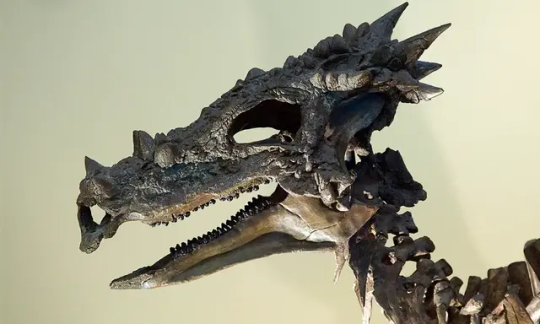

Happy Fossil Friday and Lunar New Year!
Who: Dracorex hogwartsia
name meaning: "Dragon king" "Hogwarts"
pronunciation: Drake-oh-rex Hog-warts-ee-ah
What: A pachycephalosaurid
When: Late Cretaceous
Where: South Dakota's Hell Creek Formation
Fun fact!: There is some debate over the placement of Dracorex, whether it represents its own species or if it is merely one of the ontogenetic (growth) stages of Pachycephalosaurus proper. If the later is true, it gives implications of how the dome in pachycephalosaurs is related to age and perhaps mating, only developing for sparring purposes among mating individuals. Research into microfractures and pathological resorption of bone in the domes has already corroborated.
Here is a link to a paper talking about such pathologies if anyone is interested in learning more!
Why are they cool?: Without the wicked name, Dracorex is holds an interesting place in dinosaur debate circles. There are quite a few species, including the very controversial Nanotyrannus that have been argued as seperate species vs. ontogenetic stages. These kinds of discoveries keep things interesting and offer some pretty interesting insights into how these creatures grew and lived.
Image Credits: (Left: Dragon-like Dinosaur Named 'Dracorex Hogwartsia' (roaring.earth) Right: Masato Hattori)
#palaeontology#paleontology#fossil friday#fossils#paleo#paleoart#palaeoart#Dakota#Dracorex#dragon#hogwarts#lunar new year#pachycephalosaurus#hell creek#cretaceous
8 notes
·
View notes
Text
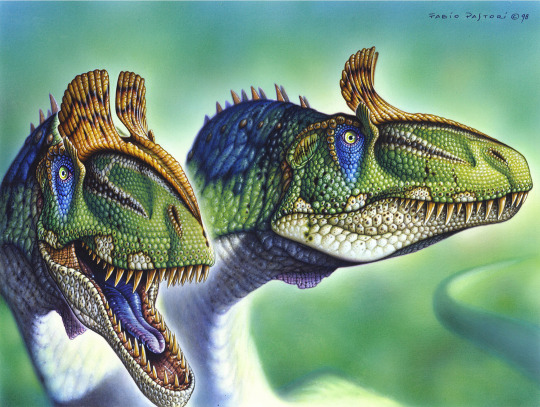

Happy Fossil Friday!
Who: Cryolophosaurus ellioti
name meaning: "Cold" "Crested" "Lizard" "David Elliot - who originally discovered the skeletal fragments of Cryolophosaurus"
pronunciation: Cry-oh-low-foe-sore-us - ell-ee-ot-eye
What: A crested theropod in the neotheropoda clade, which also includes Dilophosaurus and Dracovenator
When: Early Jurassic, Hanson Formation
Where: Central Transatlantic Mountains in Antarctica
Fun fact!: Cryolophosaurus is one of six dinosaur species discovered on Antarctica!
Why are they cool?: Like all dilophosaurids it possessed some impressive head gear, in C. ellioti this crest is formed from an elongation of the lacrimals (one of the bones in face near the orbits) and nasal bones. The purpose of these crests is still debated and with low sample sizes, difficult to dicern. Some theories include: sexual dimorphism (a difference between males and females) or recognition of species/display function.
Image Credits: (Left: Pablo Pastori Right: M. Cross)
#palaeontology#paleontology#fossil friday#fossils#paleo#palaeoart#paleoart#antarctica#cryolophosaurus#snow#dinosaur#theropod#jurassic#dilophosaurus#crested dinosaurs
15 notes
·
View notes
Text

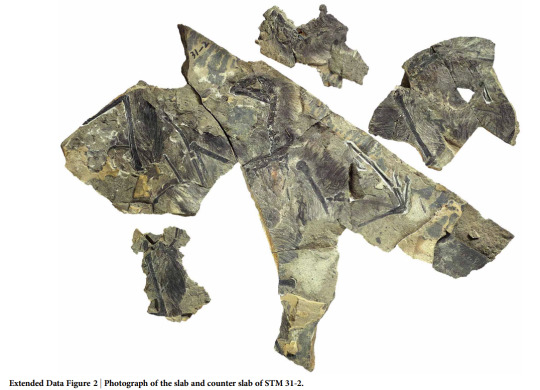
Happy Fossil Friday!
Who: Yi qi
name meaning: "Wing" "Strange" = "Strange wing"
pronunciation: Yee chee
What: a scansoriopterygid (climbing/gliding maniraptoran dinosaurs) theropod
When: Middle-Upper Jurassic
Where: Tiaojishan Formation in the Hebei Province in China
Fun fact!: Yi qi is the shortest binomial of any extinct animal discovered so far, sharing this status (ironically) with the extant Ia io, the great evening bat.
P.F. (personal flex) Fun fact!: One of the authors on the original paper describing the discovery of Yi qi was my undergraduate thesis supervisor.
Why are they cool?: When you think of birds you think feathers and Yi qi certain had those, but what sets this funky little lad apart from other maniraptorians of this time were the long rods of bone protruding from its wrists that supported membranous tissue not unlike the wings of a bat.
Here is a link to the original paper describing Yi qi if anyone is interested in learning more!
And just for fun cause she's super cool, here is a link to another of the paper's famous authers, Jingmai O'Connor's website, the punk rock palaeontologist!
Image Credits: (Left: Emily Willoughby, Right: Figure 2. Xu, Xing, Xiaoting Zheng, Corwin Sullivan, Xiaoli Wang, Lida Xing, Yan Wang, Xiaomei Zhang, Jingmai K. O’Connor, Fucheng Zhang, and Yanhong Pan. "A bizarre Jurassic maniraptoran theropod with preserved evidence of membranous wings." Nature 521, no. 7550 (2015): 70-73.)
#palaeontology#paleontology#fossil friday#fossils#paleo#palaeoart#paleoart#yi qi#china#jingmai oconnor#birds#theropod#bat#jurassic
19 notes
·
View notes
Text
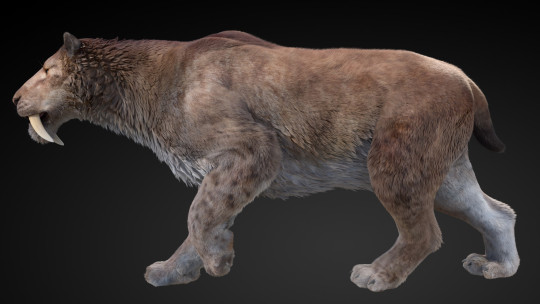

Happy Fossil Friday!
Who: Smilodon
name meaning: "two-edged knife" "tooth"
pronunciation: Smile-oh-don
What: Saber-toothed tiger, though not really a tiger at all. The Smilodon was not related to tigers or even to modern day cats. While they hail from the same family, Felidae, saber-toothed cats diverged from the ancestors of modern cats about twenty-million years ago (dates may vary among sources).
When: Pleistocene
Where: Americas
Fun fact!: There are suggestions that the discovery of Smilodon fossils was one of the inspirations for the chupacabra. There were theories that the long, curved canines protruding from the skull might act like straws, sucking the blood from unsuspecting goats.
Why are they cool?: Unlike modern big cats like leopards and tigers, the Smilodon was probably ground bound, lacking a long tail required for balance and unable to climb trees or perch on high branches. This didn't mean it wasn't a pro jumper, able to conceal itself in vegetation and take down prey with small bursts of energy. An excellent ambush predator.
Image Credits: (Left: Sergei Ostankov, Right: Smilodon fatalis Skeleton Stock by LEXLOTHOR on DeviantArt)
#palaeontology#paleontology#fossil friday#fossils#paleo#palaeoart#paleoart#smilodon#saber tooth tiger#saber tooth cat#ice age#pleistocene#north america#south america#chupacabra
16 notes
·
View notes
Text
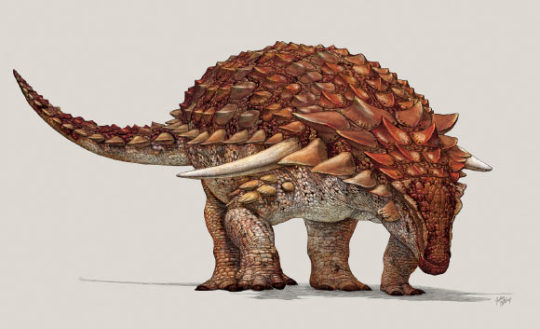

Happy Fossil Friday!
Who: Borealopelta markmitchelli
name meaning: "Northern shield" "Mark Mitchell"
pronunciation: Bore-ee-al-oh-pell-tah Mark-Mitchell-eye
What: A nodosaur, the un-clubbed kin to ankylosaurs
When: Early Cretaceous Period
Where: Alberta, Canada
Fun fact!: The specimen pictured above is one of the most well preserved dinosaurs ever discovered. It was discovered by miner Shawn Funk at Millennium Mine oil sands just north of Fort McMurray in Alberta. This local was perfect for exceptional preservation as the deposits were predominantly bitumen-rich (coal) sands. Preserved on the animal are not only skin impressions, but a snapshot image of what the animal would have looked like in life, and even red pigments have been found that indicate the hue of the skin.
Image Credits: (Left: Meet Borealopelta markmitchelli, ‘Best-Preserved Armored Dinosaur’ | Paleontology | Sci-News.com Right: M. Cross)
#paleontology#fossil friday#palaeontology#fossils#paleo#palaeoart#paleoart#canada#borealopelta#nodosaur#alberta#coal mining#mummified dinosaur
262 notes
·
View notes
Text


Happy Fossil Friday!
Who: Dunkleosteus sp.
name meaning: "Dunkle's bone"
pronunciation: Duncle-oss-tee-us
What: One of the most famous placoderms, or armored fish.
When: Late Devonian Period
Where: North America, Poland, Belgium, and Morocco. Best known from the Cleveland Shale.
Why are they cool?: Reaching lengths of up to 9 metres long it possessed thoracic and cranial armour (covering just anterior to the abdomen to the head). This armour consisted of bony plates that protected the head and neck and formed points over the jaw, like built in, armoured teeth for grasping and slicing.
Here is a link to a course on early vertebrate development and bony fishes from the Devonian and other periods, it is a wonderful MOOC (massive open online course) created by the University of Alberta, check it out if you want to learn more about Dunkle and his relatives!
Image Credits: (Left: M. Cross. Right: Figure 9 from Week 3 course notes of Paleontology: Early Vertebrate Evolution on Coursera.com)
#palaeontology#paleontology#fossil friday#fossils#paleo#palaeoart#paleoart#dunkleosteus#marine fossils#placoderm#fish#early vertebrate evolution#armoured fish
10 notes
·
View notes
Text
Beautiful! ✨
The sun rises over Dimetrodon as it travels across the landscape of the Middle Permian, spotting Diplocaulus, Titanoptera, a speculative proto-archosauromorph, and Prionosuchus along the way.
The piece 'Morning, when time had no end' was very kindly composed for this animation by the immensely talented Villi-refurinn. Check them out on Bandcamp for more fantastic music!
This one took a lot longer than usual, with life getting in the way and all that. Thank you all sincerely for waiting for so long!
4K notes
·
View notes
Text


Happy Fossil Friday!
Who: Anomalocaris canadensis
name meaning: "Odd shrimp" "from Canada"
pronunciation: Ah-nom-ah-low-care-iss can-ah-den-sis
What: A Dinocarid, radiodont arthropod with two long grasping appendages and large compound eyes. A ray of wing-like projections along the trunk and fish-like tail.
When: Cambrian Period (Anomalocaris sp. ranged 516 to 505 Ma)
Where: Burgess Shales British Columbia, Canada. From the Stephen/Burgess Shale Formation.
Fun fact!: A. canadensis is the type species for the Anomalocaris genus within Anomalocaridae and bonus fun fact: Since Anomalocaris are soft bodied organisms, they do not preserve well (usually) in the fossil record, with the exceptional cases of place like the Burgess Shale in BC. For many years, palaeontologists believed that Anomalocaris was actually three separate organisms, due to the poor preservation of the "softer" portions of the body, making it seem like the frontal appendages, mouth parts, and trunk of the animal were from different creatures. Exceptionally preserved specimens like the Left image above, show Anomalocaris in full form.
(def: the "type species" is the species upon which a genus's description is based and for which the genus is named and associated with).
Why are they cool?: Apart from the charismatic (in my personal opinion "adorable") visage of this tough little arthropod, they could use their long, segmented frontal appendages to curl and grasp prey, pulling it under to the mouth to be eaten, one of the first predatory creatures to emerge during the Cambrian Explosion.
Here is a link to a video showing Anomalocaris canadensis in its natural habitat from the wonderful Burgess Shale website, for those interested, check out their other videos on Burgess Shale/Cambrian fauna.
Image Credits: (Left: Fig. 1 - Daley, Allison C., and Gregory D. Edgecombe. “Morphology of Anomalocaris Canadensis from the Burgess Shale.” Journal of Paleontology 88, no. 1 (2014): 68–91. https://doi.org/10.1666/13-067. Right: M. Cross)
#palaeontology#paleontology#fossil friday#fossils#paleo#anomalocaris#cambrian#cambrian explosion#burgess shale#canada#british columbia#arthropod#anomalocaris canadensis
22 notes
·
View notes
Text

Merry Christmas!
From the Palaeonecromancy crew and Wally the Sauropod, a very Merry Christmas and Happy Holidays to you!
Good food, good company, good giving.
🦕❤️
2 notes
·
View notes
Text

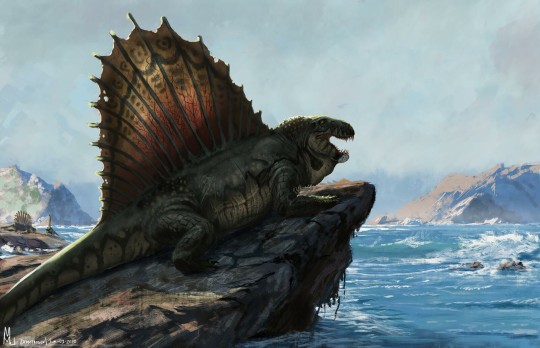
Happy Fossil Friday!
Who: Dimetrodon grandis
name meaning: "two-measures-of-tooth" "large"
pronunciation: Dime-ee-troh-don gran-dis
What: Dimetrodon, a quadrupedal synapsid with a large dorsal sail
When: Permian period (279.5 to 272.5 Ma (Million Years Ago))
Where: USA (Texas and Oklahoma)
Why are they cool?: Dimetrodon are actually closer related to us than to dinosaurs! Though this particular group was not directly ancestral to mammals, they shared the temporal fenestrae (singular socket behind the orbit) with other synapsids that would become the ancestors to Mammalia.
Here is a link to a cute video showing some of the representations of Dimetrodon over the years, a very popular cameo in Dinosaur media.
Image Credits: (Left: M. Cross. Right: Marcos Villarroel, arstation.com)
#palaeontology#paleontology#fossil friday#fossils#paleo#palaeoart#paleoart#Dimetrodon#Dimetrodon grandis
44 notes
·
View notes
Text
Fun fact! Yi qi has the shortest scientific name to date of all fossil organisms and shares this record with the bat Ia io the Great Evening Bat, which also shares its characteristic membranous wings!

Yi qi
Still gonna try and finish the list, won't happen this year though :')
397 notes
·
View notes

